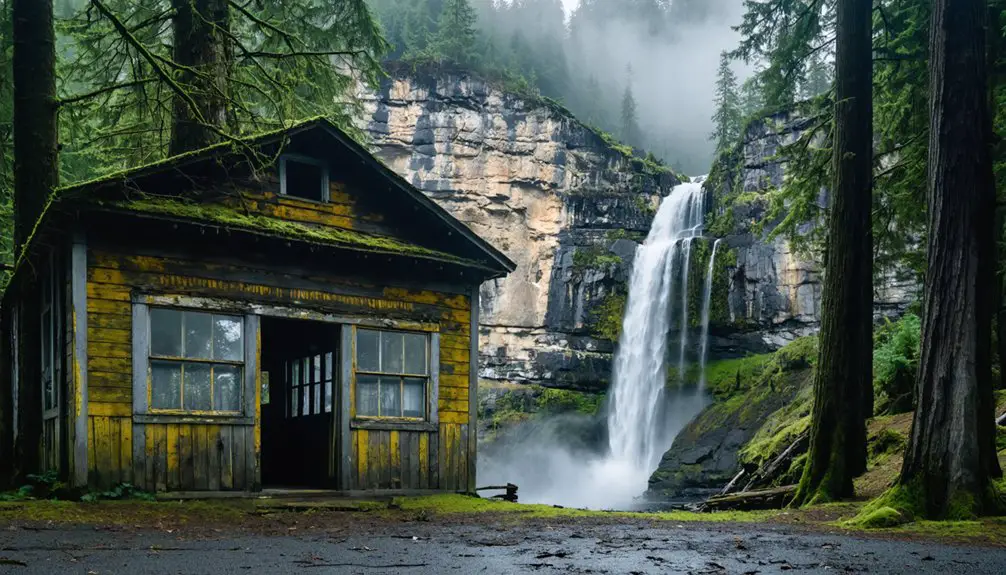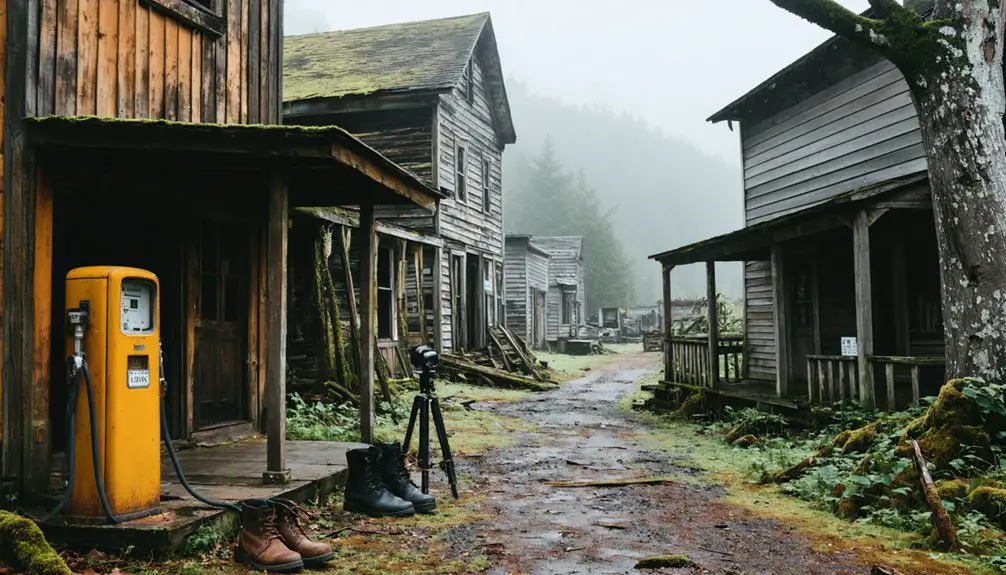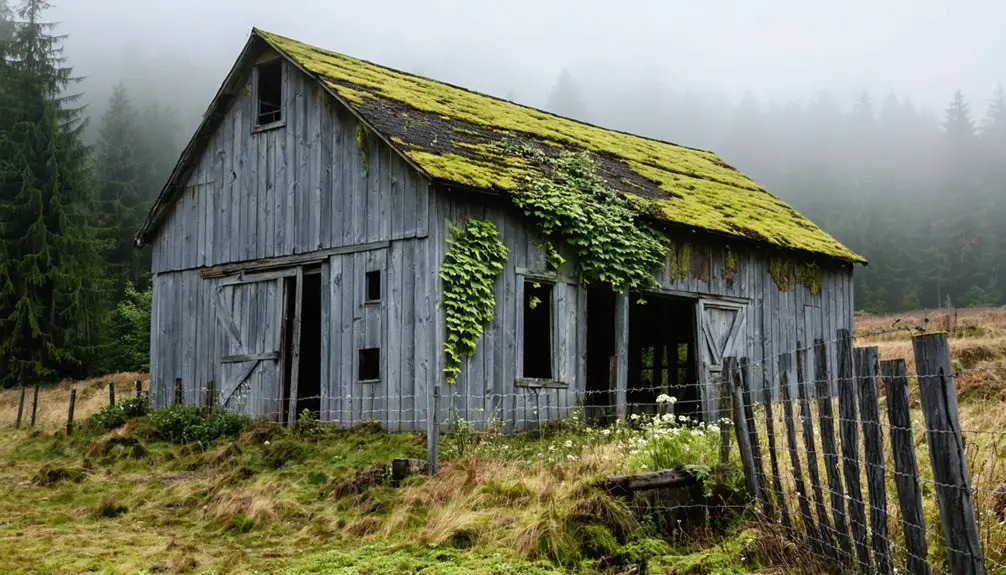You’ll find Latourell nestled in Oregon’s Columbia River Gorge, where Joseph “Frenchy” Latourell established a thriving timber town in the 1850s. His mercantile store, post office, and saloon formed the heart of this once-bustling community, while a 12-mile lumber flume system powered its economy. Though the town declined after a devastating 1916 fire, its stunning 224-foot waterfall and historic landmarks now tell a compelling story of pioneer ambition and natural wonder.
Key Takeaways
- Latourell transformed from a bustling timber town to a ghost town following economic decline and the devastating 1916 fire.
- The closure of the post office in 1964 marked a significant milestone in Latourell’s transition to ghost town status.
- Key founding families relocated and commercial logging operations ceased, leading to the community’s gradual abandonment.
- While mostly abandoned, Latourell’s historic significance lives on through tourism centered around its 224-foot waterfall.
- The town’s original structures largely disappeared, but preserved remnants include the Historic Columbia River Highway and natural landmarks.
Origins and Early Settlement
When Joseph “Frenchy” Latourell immigrated to Oregon in the 1850s, he established what would become the foundation of Latourell town. After marrying Grace Ough, a Native American woman, in 1859, the couple’s home became a social hub for the growing community.
Blending cultures and building community, the Latourells created a welcoming space that helped shape early Oregon settlement life.
You’ll find that early settlers in the area connected through a telegraph line that followed an ancient Indian trail linking Celilo and Oregon City.
The town’s development centered around Latourell’s entrepreneurial spirit. He operated a mercantile store, worked as a boatman on the Columbia River, and ran a fish wheel. The bustling community featured five active saloons and regular entertainment for visitors and locals alike. The area eventually became a popular destination for visitors who arrived by Columbia River steamboats.
When he became postmaster in 1876, the local post office, originally called Rooster Rock, took on the name Latourell Falls. The settlement’s strategic location along the river made it a natural gathering point for pioneers seeking new opportunities.
The Latourell Family Legacy
Through their extensive community involvement, the Latourell family shaped the social and economic fabric of their namesake town. Joseph Latourell’s store and saloon became important gathering spots, while his role as postmaster and telegraph operator established significant communication links throughout the Columbia Gorge region. Like George Shepperd’s generous land donation, the Latourells’ actions demonstrated a deep commitment to public service and regional development.
The family’s community contributions extended far beyond basic commerce, creating lasting impacts on local education and social life.
- Built and supported a two-room schoolhouse with a multipurpose assembly hall
- Hosted cultural events and musical performances that drew visitors from Portland
- Operated essential services including the mercantile store and post office
- Maintained key transportation and communication routes that connected trading points
Their leadership in developing infrastructure and fostering community cohesion transformed Latourell from a remote logging area into a vibrant social hub.
Timber Industry and Economic Growth
You’ll find the origins of Latourell’s economic boom in the 1880s, when commercial logging operations transformed this Columbia River settlement into a bustling timber town.
The Columbia River Lumber and Fuel Company emerged as a major employer, utilizing an extensive 12-mile flume system to transport lumber while employing up to 200 workers. Henry Latourell constructed the initial flume in 1889.
The demand from gold-rush California helped drive the rapid growth of timber operations in the region. The town’s prosperity became evident in its five thriving saloons, served by a railway station that connected Latourell’s timber products to broader markets.
Sawmills and Railway Transport
As Latourell transformed into a bustling timber town in the 1880s, the establishment of major sawmill operations and railway connections catalyzed its economic growth.
You’ll find evidence of sawmill innovations through the Columbia River Lumber and Fuel Company’s impressive operation near Goble Creek, where 150-200 workers managed extensive timber processing. The railway expansion brought the Oregon Railway and Navigation line, connecting you directly to broader markets and transportation networks.
- A sophisticated double flume system stretched over 12 miles through timberlands
- Henry Latourell’s expertise helped construct essential lumber flumes between Mooresville and Goble
- The dedicated “Latourell” railway station served as a significant logistics hub
- Sawmill ponds and lath factories showcased the scale of local timber processing
Booming Five-Saloon Economy
The five bustling saloons of Latourell marked the timber town’s economic peak in the 1880s, serving as crucial social and business hubs for the region’s growing workforce.
You’d find these establishments teeming with loggers and laborers, who’d gather to unwind, share news, and strike business deals after long days in the woods.
The saloons’ significance extended beyond just serving drinks – they were critical players in Latourell’s leisure economy.
These establishments supported a thriving brass band, complemented the town’s dance halls, and helped retain workers in the area.
With over 150 men employed in nearby lumber operations, the saloons catered to both permanent residents and transient workers, contributing to a micro-economy that included food sales, entertainment, and informal business networking.
Community Life and Social Scene
During its heyday in the late 1800s, Latourell served as a vibrant social hub where settlers from the surrounding countryside gathered to exchange news and meet their neighbors.
The town’s community engagement centered around shared spaces that fostered social gatherings and cultural activities. You’d find locals coming together at the telegraph office, mercantile store, and the two-story schoolhouse that doubled as a dance hall. The town’s role as a lumber and railroad stop made it a natural meeting point for workers and travelers alike. Similar to other Oregon frontier settlements, the community faced challenges from natural disasters that impacted daily life.
- A local brass band provided musical entertainment, highlighting the town’s cultural spirit
- The upstairs hall hosted dances, basketball games, and later became a popular skating venue
- Joseph Latourell’s telegraph office kept residents connected to the outside world
- The schoolhouse served both educational and social functions, bringing rural families together
Natural Landmarks and Geographic Features

Nestled within the dramatic Columbia River Gorge, Latourell’s natural landmarks showcase some of the Pacific Northwest’s most striking geological features.
You’ll find the 224-foot Latourell Falls plunging over distinct layers of columnar basalt, formed 15.5 to 14 million years ago. The waterfall geology includes an impressive undercut cliff face, creating a natural amphitheater that’s enhanced by vibrant chartreuse-colored lichen.
As you explore the area’s 2.4-mile loop trail, you’ll encounter both Lower and Upper Latourell Falls amid dense forests of Port Orford cedars, Douglas-firs, and maples. The area was permanently preserved when Guy W. Talbot donated the land in 1929. The trail features several scenic picnic areas perfect for resting while taking in the natural beauty.
The lichen biodiversity stands out against the dark basalt columns, while seasonal wildflowers dot the landscape. Henderson and Latourell Creeks wind through the terrain, feeding these magnificent falls that draw visitors year-round to this former settlement.
The Path to Becoming a Ghost Town
As lumber operations and steamboat traffic fueled Latourell’s early growth in the late 1800s, Joseph Latourell established a thriving community centered around his mercantile store, saloon, and postal service.
You’ll find that transportation shifts gradually eroded the town’s significance, starting with the railroad’s dominance over river transport and later the Columbia River Highway’s construction.
The town’s economic decline accelerated through several key events:
- The devastating 1916 fire that destroyed Shoults’ grocery store
- Closure of essential businesses and relocation of founding families
- Diminishing commercial logging operations in the region
- The post office’s final closure in 1964
Modern Tourism and Historical Preservation

Today, Latourell Falls stands as the area’s primary tourist attraction, drawing visitors from nearby Portland and beyond to experience its dramatic 249-foot cascade.
You’ll find it’s one of 90 waterfalls along the Columbia River Gorge, where tourism impact has shaped local economies through guided tours, photography excursions, and hiking adventures. Community interest has helped protect historical structures through ongoing preservation efforts.
To manage this influx of visitors, preservation strategies focus on maintaining the Historic Columbia River Highway’s status as a National Historic Landmark while protecting the surrounding environment.
You’ll notice interpretive signs that tell the story of Latourell’s past, while updated trail infrastructure guarantees safe access to historic sites.
Local organizations work together to balance tourism demands with conservation needs, implementing measures to prevent environmental degradation and preserve the area’s natural and cultural heritage for future generations.
Frequently Asked Questions
Are There Any Reported Ghost Sightings or Paranormal Activities in Latourell?
You won’t find documented ghost encounters or paranormal investigations in Latourell, though Oregon’s ghost towns frequently spawn supernatural tales. The area’s eerie atmosphere hasn’t produced specific verified paranormal reports.
What Happened to the Descendants of Joseph Latourell’s Eight Children?
While you’d expect descendant stories to center on Latourell, Joseph’s family legacy scattered across the Pacific Northwest as his children’s families moved away during the mid-1900s, following economic opportunities beyond their ghost town roots.
Can Visitors Legally Explore and Photograph the Remaining Buildings Today?
You’ll need to verify site regulations before exploring any structures, as most are likely on private property. Photography guidelines allow shooting from public areas, but don’t trespass for interior building access.
Were There Any Major Crimes or Notable Incidents During the Town’s Peak?
You’ll find no major crime history during the town’s peak period. While five saloons operated and typical lumber town activities occurred, notable incidents mainly centered around community gatherings and accidental fires.
Did Native American Tribes Have Settlements in the Area Before Latourell?
You’ll find Chinookan-speaking tribes established settlements in this area, following seasonal patterns along the Columbia and Sandy Rivers. Their tribal history includes fishing camps and permanent villages near Latourell’s future location.
References
- https://vintagedava.com/2023/04/18/history-lesson-tuesdays-do-you-remember-latourell-oregon/
- https://en.wikipedia.org/wiki/Latourell
- https://en.wikipedia.org/wiki/List_of_ghost_towns_in_Oregon
- https://www.youtube.com/watch?v=FSOhpvvN-Zg
- https://sites.google.com/view/recreatingthecrh/historic-columbia-river-highway/crown-point-to-latourell/latourell
- https://adventurespnw.com/latourell-falls-hike/
- https://www.troutdaleoregon.gov/community/page/brief-history-troutdale
- https://sites.google.com/view/recreatingthecrh/historic-columbia-river-highway/crown-point-to-latourell/guy-w-talbot-state-park
- https://wyeastblog.org/2014/05/06/heirs-to-george-shepperds-legacy/
- https://wyeastblog.org/tag/shepperds-dell/



